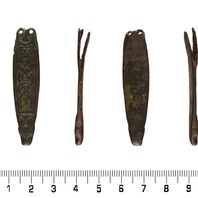
Viking Objects
Decorated Strap-End (WMID-2D6997)
A copper-alloy Thomas Class A Type 1 strap-end with a section at the top which splits into a ‘V’ shape. The strap-end is decorated with what seems to be a stylized face above some interlaced knotwork while the tip features a stylized beast head.
Read More
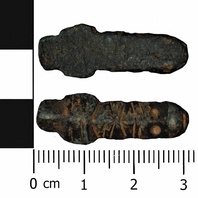
Viking Objects
Zoomorphic Strap-End (LANCUM-E11AB2)
This Thomas Class B, Type 4 strap-end has a pointed zoomorphic terminal moulded to represent an animal head with large semi-circular eyes and ears in Trewhiddle style. There are possible traces of niello in the recesses. .
Read More

Viking Names
Stein
Originally a byname, Steinn ‘stone’ is a very common personal name across Scandinavia. It appears early and remains fairly common as a personal name in both Norway and Iceland. As a personal name, the later form Sten is fairly common in Sweden and Denmark. Several instances are recorded as a byname in Denmark, possibly as a loan from Sweden. The name may also be found in a place-name in Normandy. It is also the first element in Stenson, Derbyshire.
Read More
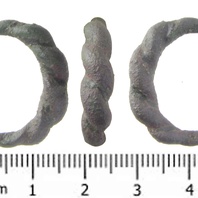
Viking Objects
Copper-Alloy Finger-Ring (SWYOR-AA27B1)
This copper-alloy finger-ring seems as if it was made from two strands of twisted wire, but could possibly have been cast. The ropework hoop may have been gilded. Even though similar designs are known from the Viking period, they were also used in other periods as well. Hence, the large date range.
Read More
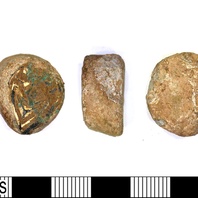
Viking Objects
Gilded Lead-Alloy Weight (LEIC-C6C96A)
The inset decoration of this weight is probably a reused fragment of an Irish or Anglo-Saxon object. Its importation and re-working is likely the result of Viking intervention. The distinction of weights by embedded objects or other embellishments in various media is a widely recognised feature of some early medieval weights. Weights are an important form of evidence for Viking Age commerce and the use of standards across the different economic systems within which Vikings were integrated. Many of the weights discovered, particularly ones in Ireland and those of Arabic type, suggest that a standardized system of weights existed in some areas. These standard weights, alongside standard values of silver, are what allowed the bullion economy of Viking-occupied areas to function. A bullion economy was a barter economy that relied on the exchange of set amounts of precious metal in various forms, such as arm-rings or coins, for tradeable goods, such as food or textiles. Each merchant would have brought their own set of weights and scales to a transaction to make sure that the trade was conducted fairly.
Read More
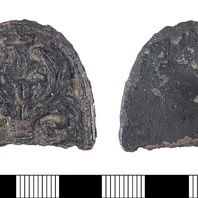
Viking Objects
Carolingian-Style Strap-End (LIN-9A2879)
It has been suggested this this strap-end came from a sword harness and, therefore, is classed as Thomas’s Class E, Type 1. The strap-end bears Carolingian-style relief decoration of a palmette set within a stylised plant with acanthus foliage and brush-like leaves. It does now show any evidence of gilding. Carolingian belt fittings from England could have been imported either indirectly through Scandinavia or directly from the Continent. It is possible that this strap end was brought over by Scandinavians as a result of their raids on the continent. Gabor Thomas suggests that the localisation of similar types of strap ends, known as Aspatria-type, in the Irish Sea region could indicate that they were worn by Scandinavian communities in that area.
Read More
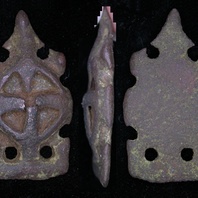
Viking Objects
Copper-Alloy Strap-End (LEIC-982247)
This Anglo-Scandinavian copper-alloy strap-end is decorated with a sub-circular dome which is flanked by eight circular holes joined into pairs by a recessed channel creating a raised ‘cross’. There are very faint traces of possible ring and dot motifs on the surface of the cross. It has been classified as a Thomas Class E.
Read More
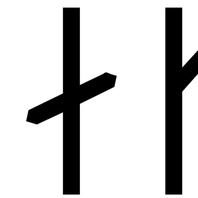
Viking Names
Klakk
Klakkr, an original byname from Old Norse klakkr, probably a ‘peg on saddle on which baggage is hung’, appears in a few recordings in West Scandinavia. The name is related to the byname Klakka, which appears early and often in West Scandinavia. Klak is also recorded in Sweden and found in some Danish place-names. Klakkr is the first element of Claxby, Lincolnshire.
Read More
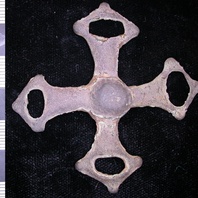
Viking Objects
Harness Strap-Divider (LEIC-0DF1A3)
This harness strap-divider is cross-shaped with a central domed boss. The loops would have held leather harness straps and were usually placed at the side of a horse’s head.
Read More
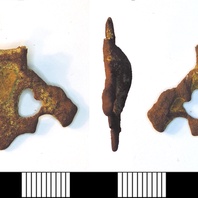
Viking Objects
Harness Mount (LEIC-9EB6F8)
This incomplete Anglo-Scandinavian harness mount or pendant seems to be decorated with a stylised animal head and may have been lozenge-shaped.
Read More
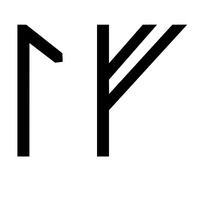
Viking Names
Ulf
Úlfr is a very common name throughout Scandinavia, meaning ‘wolf’. It is also frequent in England, occurring both independently and in place-names like Ulceby Lincolnshire and Ullesthorpe, Leicestershire. While Old English has a personal name element Wulf, common in compound names such as Wulfstan, it is very rarely used on its own as a monothematic name, unlike the Old Norse cognate. The Old Norse name can also be found as both the first and second element in compound names, such as Úlfgeirr or Þórulfr. The name is also found in a sundial inscription from Aldbrough, East Yorkshire, along with the female name Gunnvor.
